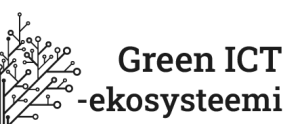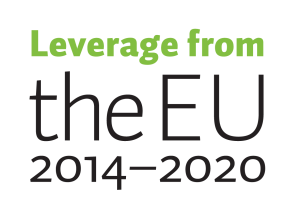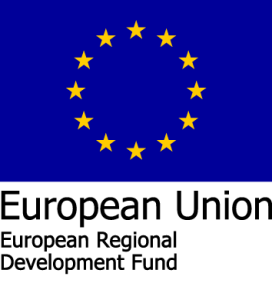
The objective of environmentally conscious digital service production rests on the foundation of competitive and cost-effective research and development activities in Green ICT. ICT solutions form a total of about 4-10 percent of all annual electricity produced and contribute to 3-5 percent of all global greenhouse gas emissions. Moreover, ICT is the fastest-growing field when it comes to both energy consumption and the consequent carbon footprint. GeSI estimates that the sector’s footprint will be tripling within this decade.
Therefore, the ICT sector immediately needs to consider the significant footprint of its activities in terms of power consumption and greenhouse gas emissions. However, ICT services can themselves be significant influencers in reducing the carbon footprint of areas or services where they are employed. This is well emphasised by the Finnish government in their Climate and Environment Strategy for the ICT sector. As producers of ICT products and services, it is crucial for ICT companies to align their procurement, production, and supply practices in the direction of Green ICT. R&D activities are crucial in this transition and should be undertaken as a cost-effective, profitable exercise. Going forward, in the face of government compliance norms, Green ICT practices can potentially be a new differentiator and new driver for profits. In the following subsections, we explain the various aspects of R&D in the Green ICT sector.
4.1 Policies Emphasising Green ICT Activities
The European Union has been active in tackling climate change and environmental degradation with its green transition programmes. According to “A European Green Deal” programme published in 2019, Europe aims to be the first climate-neutral continent. The European Green Deal will transform the EU into a modern, resource-efficient, and competitive economy, ensuring a) no net emissions of greenhouse gases by 2050, b) economic growth decoupled from resource use, and c) no person and no place left behind. The European Green Deal sets the blueprint for transformational change in various sectors, and ICT will play a pivotal role in many of them. For example, 40% of our energy consumption is related to the construction and temperature regulation of buildings, while transport represents 25% of our emissions. ICT has been shown to provide solutions that reduce both energy consumption and emissions.
Finland was one of the first countries to publish a climate and environmental strategy for the ICT industry in March 2021. The published strategy illustrates both the positive and negative effects of the ICT sector. It presents goals and measures for six different thematic areas. These areas highlight the potential influence of different technology areas and stakeholders in implementing the strategy. ICT devices are mainly examined in correspondence with the climate and environmental friendliness of the ICT infrastructure. Regarding digital devices, the intention is to both develop the energy efficiency of software and consider their energy consumption and the minimisation of its consequences (e.g., utilisation of waste heat, recycling of resources). Devices are also touched upon in the section on “Sustainable material flows and circular economy.” This section examines the use of primary materials, extending the life cycle of digital devices, and recycling of devices. Topics related to software are examined in the “Climate and environmental friendliness of data economy” section. Regarding software, energy efficiency needs to be considered when designing and procuring them.
In addition, benefits obtained through using sustainable software are emphasised. The strategy has its section related to knowledge and understanding. The theme, “Expanding the knowledge base and developing measurement,” foregrounds suitable metrics’ development work and usage. Correspondingly, the theme titled “Increasing consumer awareness and competence” highlights increasing the competence of all stakeholders on the use of sustainable ICT devices and services. Finally, the theme “Using emerging technologies and responding to challenges” aims to consider the role new technologies play in fulfilling the strategy’s goals.
4.2 Advancing Green ICT in Companies
Currently, there is an increased interest in companies to tackle the important issue of calculating and reducing their emissions and energy consumption. This is due to both the publication of the national ICT climate strategy and an increase in EU requirements for reporting an organisation’s environmental, social, and governmental impacts (ESG). There are several steps before a company can effectively utilise Green ICT or a business idea can be transformed into a new one. These steps are interconnected, and the true benefit of earlier steps may only become apparent at a later stage.
4.2.1 Company Vision and Necessary Awareness
The first step for any company to contribute to and utilise Green ICT is setting clear objectives. A company needs to be aware of its current environmental impacts (footprints and handprints). The company can’t start implementing its Green ICT activities without a clear goal and the required knowledge. One of the first activities the company needs to perform is to make clear how each objective materialises at different levels of the company. For example, if a company states in its objectives that it wants to “grow sustainably” and in its mission, “We commit to protecting the environment”, what do these statements mean in the everyday work of product managers? And how do they show up in the work of developers?
4.2.2 Business Models for Green ICT
No objectives should come without a proper plan on how the objectives affect the business. As a company has set its objectives, reflection on how the new environmentally friendly ways work in its everyday operations is needed. The company must also review how producing Green ICT solutions affect its other operations.
An often-neglected step is creating a proper Green ICT business plan for the company. A business plan details the business idea, estimates income and expenses for the company, gives insight into the market, and might also highlight the skills of the entrepreneur and staff. It can function as an early roadmap for the company. While not mandated by law, a formal business plan is almost guaranteed to be required by any funding instrument. Templates and other materials for writing a business plan are available from multiple sources, such as Chambers of Commerce, Suomen Yrittäjät, Uusyrityskeskus, Ministry of Economic Affairs and Employment, Technology Industries of Finland NGO, and Suomi.fi -portal.
After creating a business plan, several actions can be taken concurrently.
4.2.3 Sustainable Business Processes
Sustainable business processes are practices and procedures that aim to integrate environmental, social, and economic considerations into the operations of a business. These processes promote long-term sustainability by minimising negative impacts on the environment, society, and future generations while maximising positive contributions.
Sustainability in business is often considered as implementing the necessary tools and actions, like Green ICT practices and the responsible use of energy and natural resources, and rightly so. However, a sustainable business should start with the planning of the business model, operations, processes, and their relevance for the outcome, as well as business needs and regulatory requirements.
Some sustainability-related topics to be considered while designing business processes are, e.g., Resource Efficiency, Supply Chain Management, Green Procurement and Green ICT, Life Cycle Assessment, Waste Management, Employee and Stakeholder Engagement, and Continuous Improvement and Innovation.
Sustainable business processes involve a commitment to continuous improvement and innovation. This includes regular reviews and updates to processes to incorporate the latest sustainability practices, embrace new technologies, and seek innovative solutions to challenges.
By integrating sustainable business processes into their daily operations, organisations can reduce their environmental footprint, promote social responsibility, and contribute to a more sustainable and resilient business. Sustainable business is a balancing and prioritisation question, Green transition should be viewed as an investment with a clear return on investment, like any other business development. It often requires R&D inputs and innovation on the front end, while resulting in customer and employee satisfaction, marketing advantage and opening new markets on the back end.
International recommendations and national regulations also support these targets and actions. Internationally the seventeen UN Sustainable Development Goals create an overarching framework for sustainable business processes, supplemented by UN/ECE Trade Facilitation Recommendations. Nationally, an example of the regulatory framework supporting Sustainable Business Processing in the area of data utilisation is the Finnish Act on Information Management in Public Administration (906/2019).
4.2.4 Educating and Engaging the Necessary Stakeholders
Good vision, innovative business plans, and efficient processes do not materialise unless the necessary stakeholders are engaged in the activities.
For example, suppose the developers of some software solutions within a company do not know how the high-level business objective is linked with the context of the software. In that case, one cannot expect them to consider the objective in the development process. This requires clear communication with the company regarding the meaning of the objectives at each level. This part may, however, require some research (e.g., analysis of the possible impacts and selection of the ones emphasised), education of the management and development staff, and adjusting the (development) processes to incorporate the sustainability goals.
Customers may also need to understand the new business goals and business models. Implementing sustainability into products requires some effort and resources and thus may affect the costs of an ICT solution. Customers should, in their procurement process, be aware of this and, if emphasising sustainability, take it into account. The costs of the investment of implementing sustainability in products will eventually be paid by the customers, either as investments or as operating costs.
4.2.5 Funding for the Green Transition
Acquiring capital for a new company in Finland can be achieved from multiple different sources, both internal and external, as well as from public or market sources. The type of funding can also vary from gratuitous support to loans. It’s also possible to sell company shares in return for an investment.
Just as funding sources can vary, so can the funding target. These can consider e.g., innovation, development of new products and services, employing additional staff, or expanding into the international market. However, there are often strict conditions for funding to be granted. For example, there might be a requirement for sufficient material and staff resources available, which demonstrates that the funding received is used appropriately. In Finland, organisations providing funding for businesses include Business Finland and the regional Centers for Economic Development, Transport and the Environment. Certain niche industries can also be targeted for funding by different funds, foundations, and governmental entities.
Funding can also be acquired from investors and business angels in return for a stake in the company. Especially in tech, investors are willing to take a risk; often, they can be valuable advisors on how to operate the business as well. Entrepreneurs should, however, be wary of selling more than 50 % of the company, as that will cede control to the investor.
In Finland, entrepreneurs can also apply for financial support from TE services, the governmental body organising employment services for job applicants.
Financing the green transition
The European Union has been investing considerably into the green transition for the last few years. At the time of writing, the Green Deal call is supporting 73 different projects with a total of 1 billion euros. However, Green Deal calls are ongoing and companies may apply their own projects to it or follow existing projects. Horizon projects require a set of partners around Europe, and for smaller companies participating may be easiest with a Finnish academic partner.
Business Finland provides various funding opportunities through their programmes for companies interested in developing their operations towards a more climate friendly direction. Business Finland works together with the Finnish Academy to promote Climate actions, for example through the ICT2023 programme.
4.2.4 Getting Help and Networking with Others
For a new company, there are various support materials and expert guidance available. The Suomi.fi portal and Suomen Yrittäjät, for example, provide a well-rounded guide for different parts of the founding process. Other organisations can provide help via business advisors, such as Finnish Enterprise Agencies and Centers for Economic Development, Transport, and the Environment. Different organisations also have mentorship programs for novice entrepreneurs. The Green ICT ecosystem managed by TIEKE is one viable forum for networking in this respect.
4.3 Research & Development Activities in Green ICT
The question of making an existing ICT product or service greener can be approached from different angles. Table 1 provides an overview of the R&D themes geared towards energy and CO2 reduction in ICT production and usage.

Going forward, another approach is to look at the Green ICT R&D effort in terms of the present to mid-term to long-term feasibility of the effort – a realisation time frame. Partitioning that time space into 3 horizons, we broadly have
● Horizon 1 (H1): State-of-the-art, that is, solutions for today.
● Horizon 2 (H2): Within the next four to six years, that is, solutions for the near future.
● Horizon 3 (H3): Beyond six years, that is, further evolution.
Also, the solution space for Green ICT solutions can be divided into four types: technical, social, environmental solutions, and paradigm shifts. An overview of this line of thinking is presented in Figure 10 and described in further detail in Verdecchia et al. (2021). Technical solutions include integrated infrastructures and high-density storage. Social solutions are e.g. more specialised training and awareness work. Environmental solutions include energy-aware software solutions, whereas breakthroughs in hardware is an example of a required paradigm shift.
When designing with the handprint in mind, the importance of understanding the customer and end-user needs cannot be overemphasised. When you meet the user’s needs as well as possible, the service or product will use resources most efficiently during its lifecycle.
Find out more about the green future of the ICT sector
- Green ICT -ekosysteemi: Korkeakoulujen ja yritysten TKI-yhteistyö, 20.10,2022. In Finnish.
References
- Verdecchia, P. Lago, C. Ebert, and C. de Vries, “Green IT and Green Software,” in IEEE Software, vol. 38, no. 6, pp. 7-15, Nov.-Dec. 2021, doi: 10.1109/MS.2021.3102254.






